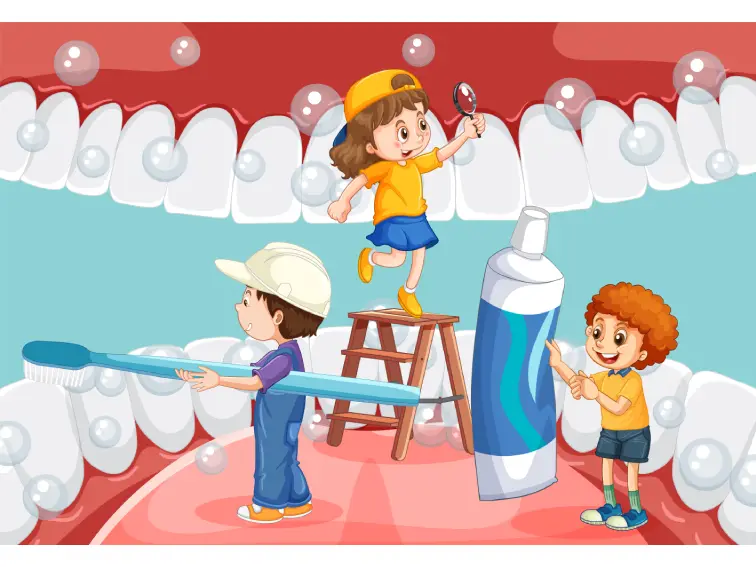
Too many teeth – Hyperdontia refers to the presence of additional teeth in a person’s mouth. While it is usually not associated with pain, it can potentially result in complications that may lead to discomfort and inflammation.
Typically, individuals grow 20 baby teeth during childhood, which are eventually replaced by 32 permanent teeth. However, in some cases, individuals may develop extra teeth, which are referred to as supernumerary teeth by dental professionals.
These additional teeth may appear in various locations within the mouth and can either be baby or permanent teeth.
Individuals who have too many teeth might also be afflicted with another ailment, such as a cleft palate or Gardner’s Syndrome, in which non-cancerous tumors develop. The remedy involves eliminating the additional teeth and utilizing orthodontic procedures to rectify the alignment of the teeth.
Classification of Hyperdontia ( Too many teeth)
Extra teeth are classified based on their shape and location in the mouth. They have the following shapes:
- Peg-shaped or conical teeth: Teeth appear sharp due to their wide base and narrow top
- Complex odontoma – tooth-like tissue grows like a disordered group
- Compound odontoma – many small tooth-like growths develop near each other
- Tuberculate – Barrel or tube-like tooth growth
- Supplemental – two nearby teeth look alike and grow together
Classification of extra teeth based on the location in the mouth.
Paramolar – An extra tooth grows out of line next to one of the molars.
Distomolar: An extra tooth grows in line behind the molars.
A majority of extra teeth are mesiodens.
Mesiodens: This is an additional tooth growing between the two central incisors — the two flat teeth at the front of the upper jaw.
Symptoms if you have too many teeth
Hyperdontia is a condition where extra teeth develop either behind or near the regular primary or permanent teeth. The primary indication of this condition is the growth of these extra teeth. This phenomenon usually occurs in adults and is more prevalent in men than in women, with twice the frequency. Hyperdontia doesn’t typically cause pain. However, overcrowding can cause swelling and pain in some cases. A majority of supernumerary teeth develop in the upper jaw.
- Teeth develop singly or in multiple
- Extra teeth develop on one or both the sides
- Teeth develop in the lower or upper jaw or in both the jaws
- Visible teeth are known as erupted and hidden one is known as impacted.
Hyperdontia Causes
The cause of extra teeth is unclear in some cases. However, they may develop due to environmental or genetic factors.
Hyperdontia may be associated with the following genetic syndromes and disorders:
Cleft lip and palate – This are a congenital defect where in a baby’s lip or mouth doesn’t form correctly during development in the uterus.
Cleidocranial dysplasia – The condition is associated with abnormal bone formation in collar area and skull.
Nance-Horan syndrome – This syndrome causes dental abnormalities and also congenital cataracts.
Fabry disease – The disorder is associated with alpha-galactosidase enzyme’s deficiency. It affects teeth, nervous system, brain and skin.
Diagnosis of Hyperdontia
Extra teeth are visible and apparent. Dentists make the diagnosis by examining the mouth. They also recommend dental X-ray to see whether these extra teeth have broken down through the gumline.
Treatment of Hyperdontia
The course of action taken for supernumerary teeth relies on the likelihood of complications arising from them. Generally, these extra teeth don’t result in any noticeable symptoms, and their existence may only be uncovered through X-ray scans. If the supernumerary teeth are not causing any problems, treatment may not be necessary. Nonetheless, in the majority of hyperdontia cases, the surplus teeth must be extracted, regardless of whether the person is experiencing any discomfort.
Your dentist may remove extra teeth if they cause discomfort, overcrowding or crookedness. Dentists also recommend removing extra teeth if they cause eating or chewing and cleaning problems. Risk of damage to unerupted permanent teeth, delay in eruption of permanent teeth, and overcrowding may necessitate removal of extra teeth.
When to see a dentist at Gnathos Dental Clinic?
If someone observes additional teeth that are not aligned with their surrounding teeth, it is advisable to visit a dentist.
Whenever there is swelling or discomfort in the mouth, it is generally recommended to seek advice from a dentist.
When a caregiver or parent notices delayed growth of permanent teeth in a child or large gaps between permanent front incisors, they should seek dental consultation.
Regular dental checkups are crucial as dentists can identify hyperdontia during routine examinations or X-rays.
Bottom Line
Gnathos dental clinic has expert dentists. They can diagnose hyperdontia in children as young as two years old. Early diagnosis can lead to better outlook for those who have hyperdontia.
If you have too many teeth to deal with, don’t worry come and visit Gnathos Dental Clinic for the best treatment.
